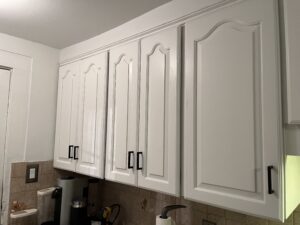Sanding is an important step in kitchen cabinet refinishing because it helps to remove the existing finish, dirt, grime, and other imperfections from the surface of the cabinets. Sanding also helps to create a smooth and even surface for the new finish to adhere to, which ensures a more professional and long-lasting result.
When you sand the cabinets, you are essentially roughening up the surface, which allows the new finish to penetrate and adhere better. If you skip the sanding step or do not sand enough, the new finish may not stick properly, which can result in peeling, cracking, or flaking.
Sanding also helps to smooth out any bumps or rough spots on the cabinets, which can improve the overall appearance of the finish. Additionally, sanding can help to remove any stains or discolorations on the surface of the cabinets, which can give them a fresh and clean look.
Sanding must be done at least twice in the refinishing process. First, once the cabinets are fully degreased, before the first coat of primer is applied. This will allow for the pores of the wood to “open up”, therefore allowing proper material absorption. The second time it’s done after the second coat of primer is applied. This will allow for the surface to achieve a “silky as smooth” finish.
In short, sanding is a crucial step in kitchen cabinet refinishing because it helps to ensure that the new finish adheres properly and looks smooth and professional.




